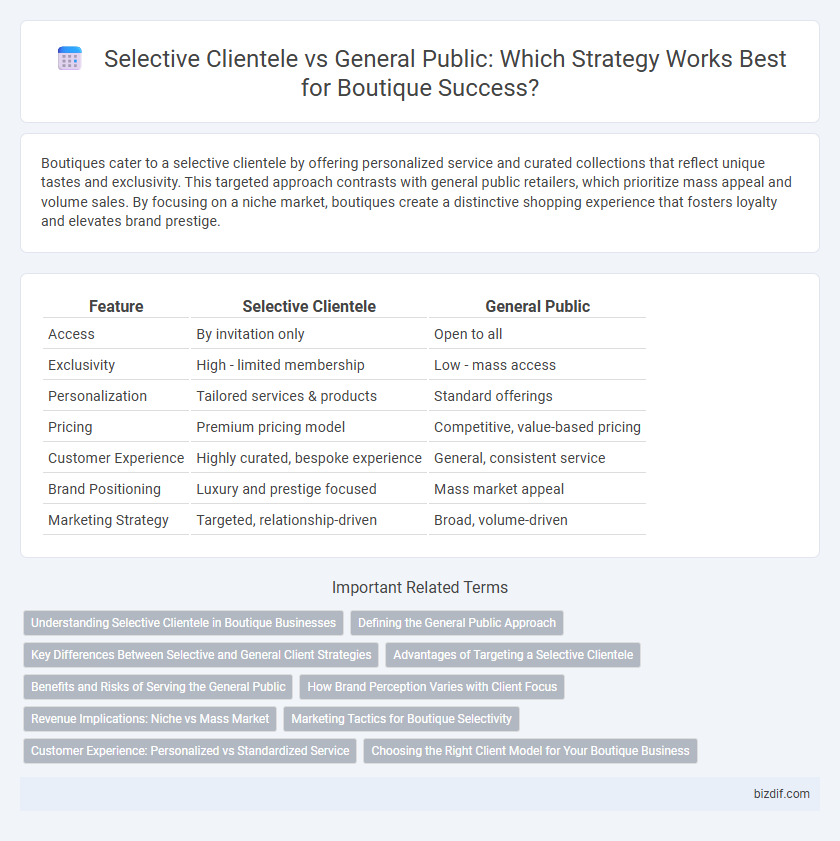Boutiques cater to a selective clientele by offering personalized service and curated collections that reflect unique tastes and exclusivity. This targeted approach contrasts with general public retailers, which prioritize mass appeal and volume sales. By focusing on a niche market, boutiques create a distinctive shopping experience that fosters loyalty and elevates brand prestige.
Table of Comparison
| Feature | Selective Clientele | General Public |
|---|---|---|
| Access | By invitation only | Open to all |
| Exclusivity | High - limited membership | Low - mass access |
| Personalization | Tailored services & products | Standard offerings |
| Pricing | Premium pricing model | Competitive, value-based pricing |
| Customer Experience | Highly curated, bespoke experience | General, consistent service |
| Brand Positioning | Luxury and prestige focused | Mass market appeal |
| Marketing Strategy | Targeted, relationship-driven | Broad, volume-driven |
Understanding Selective Clientele in Boutique Businesses
Selective clientele in boutique businesses represent a niche market characterized by discerning customers who value exclusivity, personalized services, and high-quality products. These clients often seek unique, customized experiences that reflect their individual tastes and lifestyles, fostering strong brand loyalty and higher profit margins for boutique owners. Understanding this selective clientele allows boutique businesses to tailor their marketing strategies and product offerings to meet specific demands, differentiating themselves from competitors targeting the general public.
Defining the General Public Approach
The general public approach in boutiques involves offering products and services that appeal to a broad audience rather than targeting a niche market. This strategy emphasizes accessibility, diverse inventory, and competitive pricing to attract a wide range of customers. Balancing product variety with quality ensures sustained foot traffic and maximizes revenue potential in highly competitive retail environments.
Key Differences Between Selective and General Client Strategies
Selective clientele strategies focus on personalized services, exclusive product offerings, and tailored marketing efforts to build strong relationships and loyalty, often targeting niche markets with higher purchasing power. General public strategies prioritize broad accessibility, mass appeal, and competitive pricing to attract a wide audience, emphasizing volume sales and routine promotions. Key differences include customer engagement depth, marketing customization, and brand positioning, with selective clientele approaches fostering exclusivity while general public strategies leverage scale.
Advantages of Targeting a Selective Clientele
Targeting a selective clientele in a boutique setting allows for personalized service and tailored product offerings that enhance customer loyalty and satisfaction. This focused approach enables higher profit margins through exclusive, high-quality merchandise and a strong brand identity. Selective clientele also provide valuable feedback that drives continuous improvement and innovation in the boutique's offerings.
Benefits and Risks of Serving the General Public
Serving the general public expands a boutique's market reach, increasing brand visibility and potential revenue streams while allowing a broader customer base to access exclusive products. Risks include diluting brand exclusivity and overwhelming operations with high demand, which may compromise personalized service quality that selective clientele expect. Managing this balance is crucial to maintaining a boutique's reputation for uniqueness while leveraging growth opportunities in retail.
How Brand Perception Varies with Client Focus
Boutiques targeting a selective clientele often cultivate an exclusive brand perception characterized by luxury, quality, and personalized service, which enhances customer loyalty and justifies premium pricing. In contrast, boutiques catering to the general public emphasize accessibility, trendiness, and volume sales, positioning the brand as approachable and mainstream. This focus on client segmentation directly influences marketing strategies, product assortment, and overall brand identity.
Revenue Implications: Niche vs Mass Market
Selective clientele boutiques target high-net-worth individuals seeking exclusive, high-quality products, resulting in higher profit margins per sale and increased customer loyalty. General public-focused boutiques aim for volume sales with competitive pricing, driving revenue through larger transaction numbers but often at lower margins. Balancing niche exclusivity with scalable operations can optimize revenue streams, but the strategic focus fundamentally influences pricing power, brand positioning, and long-term profitability.
Marketing Tactics for Boutique Selectivity
Boutiques targeting a selective clientele deploy personalized marketing tactics centered on exclusivity, curated product offerings, and bespoke customer experiences to enhance brand loyalty and perceived value. Employing data-driven insights, they tailor campaigns through targeted social media ads and invitation-only events, fostering a sense of privilege and community. In contrast, marketing to the general public emphasizes broad appeal, mass outreach, and competitive pricing, often diluting the boutique's niche positioning.
Customer Experience: Personalized vs Standardized Service
Boutique stores prioritize personalized service, tailoring each interaction to the specific tastes and preferences of their selective clientele, resulting in a unique and memorable customer experience. In contrast, general public retailers often provide standardized service designed to efficiently cater to a broad audience, sacrificing personalization for scalability. This customized approach in boutique settings fosters strong customer loyalty and engagement by addressing individual needs and creating a sense of exclusivity.
Choosing the Right Client Model for Your Boutique Business
Choosing the right client model for your boutique business significantly impacts brand identity and profitability. A selective clientele approach emphasizes exclusivity and personalized service, often elevating perceived value and fostering long-term loyalty. In contrast, targeting the general public increases market reach but may dilute the boutique's unique appeal and require more standardized offerings.
Selective Clientele vs General Public Infographic

 bizdif.com
bizdif.com